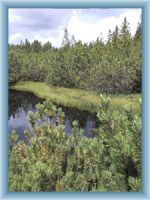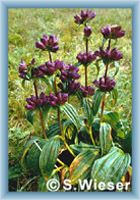Plants
Forest communities, established during the long-term development since the glaciation period, represent the dominant biotope. The mountain part of Sumava is nowadays featured by florid beech wood, mountain acidophile beech wood, and climex spruce stands. Their zonal distribution corresponds with terrain altitude. however, the natural character of those zonations has been greatly altered by long-term forest farming and the terrain altitude has recently been masked in many locations by nonidigenous spruce monocultures and deforested landscpe. At present, forest vegetation is formed by a mixture ranging from strongly changed, adapted communities up to almost natural remnants of forest communities which have been preserved in several Sumava localities (Boubin, Smrcina, Stozec, etc.).
Generally, the following floral characteristics are typical for the Sumava NP:
Zonal distribution of forest communities - beech with spruce (750 - 1100 m) - spruce with beech (1100 - 1200 m) - climatic spruce (above 1200 m).
Communities of extreme substrates (given by extreme soil conditions and high level of underground waters) - alluvial and upland peatbogs - valley-type undulating grounds (meads, forest-glades) with dwarf pine and bush pine) - mountain-type undulating grounds (moors with bog pine) - boulder scree with relic pine stands, etc. - cliffed glacial cirques hosting rare subalpine flora
Communities of non-wooded areas related to extensive farming on defrosted lands. They include the whole range of important communities - floral meadows, pastures, and grasslands - vegetation of peatlands and wetlands - opportunistic vegetation, locally regenerating into grassy wetland, on delerict and badland tracts, etc.
These meadows and pasture communities have been preserved only on a part of their original area, mainly in higher situated and badly accessible areas where they are partly amenable to natural seccession. This territory boasts the concentration of most of protected and endangered species. In connection with the post - war development of the area, a considerable part of former meadows and pastures were left to their natural development, and only a part of the areas was farmed.
As a result of natural succession, we may follow the degradation of meadow phytocenosis, the extinction of botanically important habitats, and the entire reduction of species diversity on fallow lands. Military activity affected the biotopes of bare and denaged soils which are now settled by less competitive endangered species. Regeneration of meadow peat bogs can be observed on wetlands. The abundance of flora in the Sumava NP is not given by a high nember and species diversity. The whole area is remarkable for various combinations of different factors and for the preservation of unique communities, found mainly on extreme habitats (peat bogs, lake cirques).
Source: materials of National Park of Šumava
Generally, the following floral characteristics are typical for the Sumava NP:
Zonal distribution of forest communities - beech with spruce (750 - 1100 m) - spruce with beech (1100 - 1200 m) - climatic spruce (above 1200 m).
Communities of extreme substrates (given by extreme soil conditions and high level of underground waters) - alluvial and upland peatbogs - valley-type undulating grounds (meads, forest-glades) with dwarf pine and bush pine) - mountain-type undulating grounds (moors with bog pine) - boulder scree with relic pine stands, etc. - cliffed glacial cirques hosting rare subalpine flora
Communities of non-wooded areas related to extensive farming on defrosted lands. They include the whole range of important communities - floral meadows, pastures, and grasslands - vegetation of peatlands and wetlands - opportunistic vegetation, locally regenerating into grassy wetland, on delerict and badland tracts, etc.
These meadows and pasture communities have been preserved only on a part of their original area, mainly in higher situated and badly accessible areas where they are partly amenable to natural seccession. This territory boasts the concentration of most of protected and endangered species. In connection with the post - war development of the area, a considerable part of former meadows and pastures were left to their natural development, and only a part of the areas was farmed.
As a result of natural succession, we may follow the degradation of meadow phytocenosis, the extinction of botanically important habitats, and the entire reduction of species diversity on fallow lands. Military activity affected the biotopes of bare and denaged soils which are now settled by less competitive endangered species. Regeneration of meadow peat bogs can be observed on wetlands. The abundance of flora in the Sumava NP is not given by a high nember and species diversity. The whole area is remarkable for various combinations of different factors and for the preservation of unique communities, found mainly on extreme habitats (peat bogs, lake cirques).
Source: materials of National Park of Šumava
Back Home Šumava mountains
Šumava mountains and Czech Forest - Accommodation by type:
Czech mountains - Catalogues of accommodation:


